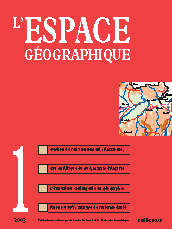

Neli Aparecida DE MELLO, Hervé THÉRY. The Brazilian government and the Amazon environment: developments, contradictions and conflicts (1 tabl., 8 fig.)
While the Brazilian government recognises the fragility of the environment of the Amazon region in official speeches, what of official policies? To analyse the spatial structures produced by those policies in the Amazon territory, the authors review the main vectors of the governments action. This review pinpoints the contradictions between different public policies, conflicts between public policies and the main axes of the Amazon in the past, the present and the foreseeable future.
keyword: AMAZON, BRAZIL, CONFLICTS, ENVIRONMENT, PUBLIC POLICY, SPATIAL STRUCTURES, TERRITORIAL CONFIGURATION
South Africas new water policy: towards environmental management of resources? (1 tabl., 4 fig.)
The 1998 Water Act marked a turning point in the environmental management of water resources in South Africa. Replacing the apartheid-era 1956 Water Act, it was implemented to protect and restore fluvial hydrosystems seriously damaged by uncontrolled industrialisation and unbalanced development between Whites and other groups in past decades. With the creation of the Reserve, the environmental value of fluvial hydrosystems has been legally recognised for the first time. But the South African Department of Water Affairs and Forestry (DWAF) also has to supply safe water to 12 million people, who still lack access to this basic resource. This paper investigates the practical problems of the implementation and enforcement of the Reserve in highly variable and substantially modified hydrosystems.
keyword: ENVIRONMENT, PUBLIC POLICY, SOUTH AFRICA, WATER
Nacima BARON-YELLÈS, Frédéric BERTRAND, Lydie GOELDNER-GIANELLA, Stéphane COSTA, Robert DAVIDSON, Gilles ARNAUD-FASSETTA, Gérard BELTRANDO. Issues and limits of the environmental management of a lagoon marsh in southern Europe: the Ria Formosa, Algarve, Portugal. (4 fig.)
The Ria Formosa (eastern Algarve) comprises salt and brackish marshes covering an area of almost 200 km2 with a highly unstable morphodynamic balance. Protected by a chain of barrier islands, the lagoon and its shores are located inside a nature reserve, whose territory is undergoing substantial change: encroaching urbanisation from a regional metropolis, changing use of embanked marshes (salt farming, fish farming) and cultivated marshes, and pressure from tourism. In this context, this paper sets out the first results of a research programme involving geographers from different disciplines (climatology, geomorphology, biogeography, human and economic geography). Given the specific conditions of a protected territory on the Algarve coast, it aims to highlight the value of an environmental study protocol comparing physical and human approaches to the environment and linking, on different scales, a general analysis and detailed studies of particularly unstable sectors, using appropriate mapping techniques.
keyword: ENVIRONNEMENT, LAGOON, MARSH, NATURE RESERVE, PORTUGAL
Applying the contingency evaluation method to urban waste.
Based on users assessment of the value they ascribe to a non marketable good, such as an environmental good, using a hypothetical scenario of damage or improvement, the contingency evaluation method provides economists with cost assessments that they can model according to technical, social or economic criteria. Using an example taken from a study conducted by the author on improving the public service of urban waste disposal in order to preserve the environment, this paper proposes moving away from the economic aim of the method, to build geographical, i.e. spatialised, indices that can be compared with other geographical criteria.
keyword: ENVIRONMENT, PUBLIC POLICY, SOUTH AFRICA, WATER
Laurent CHAPELON, Sandra BOZZANI. Air-rail intermodality in France: an analysis method (1 tabl., 11 fig., 6 cartes)
The joint development of air transport and high-speed rail raises the question of the complementarity of these two modes of fast transport. In France, the efficiency of their interconnection, at Paris Charles-de-Gaulle and Lyon Saint-Exupéry airports, has yet to be demonstrated. A space-time evaluation presents several difficulties: modelling the process of modal transfer; using data from air and rail timetables; overlapping scales of analysis, from local to global; and creating accessibility indicators sensitive to the time of departure or arrival, implying a dynamic representation in time.
This paper compares the intermodal TGV-plane offering with the monomodal air offering to measure its efficiency during the course of the day and on different dates. In the latter case, the objective is to study the impact on intermodal accessibility of the introduction of a new fast transport infrastructure, such as the TGV Méditerranée high-speed train line between Paris and Marseilles.
keyword: ACCESSIBILITY, AIRPORT, INTERFACE, INTERMODALITY, LYON-SAINT-EXUPÉRY, NETWORKS, PARIS-CHARLES-DE-GAULLE, TGV MÉDITERRANÉE, TRANSPORT
Book reviews
![]() Sixième table et index quinquennaux de LEspace géographique 1998-2002
Sixième table et index quinquennaux de LEspace géographique 1998-2002
In this issue of l’Espace géographique, you will find critical reviews of the following books
HUSSON Claude (2002). LEurope sans territoire. Essai sur le concept de cohésion territoriale. La Tour dAigues: Éditions de lAube/DATAR, coll. «Monde en cours. Bibliothèque des territoires», 202 p.
MOATI Philippe (2002). LEntreprise du XXIe siècle. La Tour dAigues: Éditions de lAube/DATAR, coll. «Monde en cours. Bibliothèque des territoires», 229 p.
PERRIER-CORNET Philippe (2002). Repenser les campagnes. La Tour dAigues: Éditions de lAube/DATAR, coll. «Bibliothèque des territoires», 280 p.
BAUDELLE Guy, OZOUF-MARIGNIER Marie-Vic, ROBIC Marie-Claire, dir. (2001). Géographes en pratique (1870-1945), Le terrain, le livre, la cité. Rennes: Presses Universitaires de Rennes, coll. «Espace et territoires», 390 p.
L’espace géographique 4/02![]()
![]() L’espace géographique 2/03
L’espace géographique 2/03
For subscribe or buy this issue: BELIN
![]() L’Espace géographique: contents
L’Espace géographique: contents
Last modified: April 15, 2003